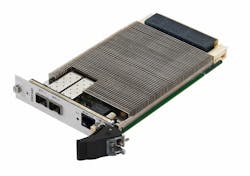After a recent meeting with the lead engineer working on one of our next generation switches, slightly off-topic, we came out of the meeting discussing central heating in our houses. Riveting stuff, I know.
You won’t be surprised to hear that it got me thinking about what helps make Abaco’s networking switches just so efficient…
Our conversation started around how much it was costing to run our respective houses in terms of heating. It’s safe to say, there was an order of magnitude of difference between the two houses. On paper there shouldn’t have been much between them; both were nearly the same square footage, both have new gas boilers, and both have good levels of insulation.
It’s rather like comparing network switch A with network switch B. Both may be the same size and weight; both may have the latest generation switch fabric; and both may have a conduction cooled heatsink. It’s only when you dig deeper and look at the architecture of each that you can see what the true differences are.
One of the best ways of designing something is to have a blank sheet of paper. That allows you to set aside the history and look to what the best solution can be. Then, you can distil that down into something that will work.
Blank sheet of paper
Going back to the two houses… With one built 200 years ago and recently refurbished, versus the other which was built less than six months ago (I talked about my new house here), a blank sheet of paper was clearly only an option with the latter. Having complete flexibility has allowed for the same number of rooms to be packaged up into a far more efficient format: keeping the hottest areas in the center allows that heat to radiate out and warm other areas, for instance. Additionally, keeping everything condensed in one area limits the amount of wasted space by having all the services (electricity, gas, water, and drainage) in one location that can be shared between multiple rooms.
When you think about that approach, it’s no surprise that our latest generation products such as the RES3000and SWE440A Ethernet switches both make use of innovative switch fabrics with integrated management processors. The benefit of that is less wastage of space for high speed interconnects; sharing of power supplies within a device rather than spread out across a board; and just one major area to focus attention on for providing the best cooling solution. That all sounds strikingly similar to a thoughtfully designed house.
With the basic structure correct, it’s then possible to further optimize it to make best use of what is provided. In the same way that you can fill a house with insulation but that may not have any more than a minor cost reduction for heating, designing a heatsink with as much metal as possible does not always solve the thermal problem of cooling powerful devices.
Cost of ownership
Looking at my house: an equal thickness of insulation was able to outperform my colleague’s by managing the flow of air through the house and capturing the heat before it leaves. Sure, it costs slightly more up front to install the fans and so on to make it possible - but in the long term, it can pay for itself many times over.
For the same reasons, we use advanced cooling methods on our products to help manage the flow of energy (heat) to take it from where it is hottest and put it to somewhere more manageable. Not only does that give us the opportunity to put more powerful devices on the board, but it also means that where a more powerful device is not needed, we can see a cooler running device with a potentially longer lifespan at extreme temperatures.
The moral of the story: if done correctly, planning ahead with the architecture and condensing key parts of a design down, and then applying cutting edge thermal management gives Abaco the ability to deliver efficient rugged solutions. In the same way that my house, thankfully, doesn’t cost a fortune to heat and less space is wasted on services, products such as the RES3000 and SWE440A can bring down the power budget down while maintaining a market-leading set of functionalities.
It’s simple really.
About the Author

